Deloz 10 Mg/Ml Oral Solution
Out of date information, search another
BLACK
COMPANY NAME: PHARMANEL PRODUCT NAME: Deloz leaf Oral 5mg-ml PRODUCT CODE.: DELOZ.leaf.01 DIMENSIONS: 150 x 560 mm PRODUCT COLORS:
EDITION:^
DATE: 22/4/2015
NOTES: FOLDING: 150X37 mm
Package leaflet: Information for the user
Deloz 10 mg/ml oral solution
Memantine hydrochloride
Read all of this leaflet carefully before you start taking this medicine because it contains important information foryou
- Keep this leaflet. You may need to read it again.
- Ifyou have any further questions, askyour doctor orpharmacist.
- This medicine has been prescribed for you only. Do not pass it on to others. It may harm them, even if their signs of illness are the same as yours.
- If you get any side effects talk to your doctor. This includes any possible side effects not listed in this leaflet. See section 4.
What is in this leaflet
1. What Deloz is and what it is used for
2. What you need to know before you take Deloz
3. How to take Deloz
4. Possible side effects
5. How to store Deloz
6. Contents of the pack and other information
1. What Deloz is and what it is used for How does Deloz work
Deloz belongs to a group of medicines known as anti-dementia medicines.
Memory loss in Alzheimer's disease is due to a disturbance of message signals in the brain. The brain contains so-called N-methyl-D-aspartate (NMDA)-receptors that are involved in transmitting nerve signals important in learning and memory. Deloz belongs to a group of medicines called NMDA-receptor antagonists. Deloz acts on these NMDA-receptors improving the transmission of nerve signals and the memory.
What is Deloz used for
Deloz is used for the treatment of patients with moderate to severeAlzheimer's disease
2. What you need to know before you take Deloz Do not take Deloz
- if you are allergic to memantine hydrochloride or any of the other ingredients of this medicine (listed in section 6).
Warnings and precautions
Talk to your doctor before taking Deloz:
- if you have a history of epileptic seizures;
- if you have recently experienced a myocardial infarction (heart attack), or if you are suffering from congestive heart failure or from an uncontrolled hypertension (high blood pressure).
In these situations the treatment should be carefully supervised, and the clinical benefit of Deloz reassessed by your doctor on a regular basis.
If you suffer from renal impairment (kidney problems), your doctor should closely monitor your kidney function and if necessary adapt the memantine doses accordingly.
The use of medicinal products called amantadine (for the treatment of Parkinson's disease), ketamine (a substance generally used as an anaesthetic), dextromethorphan (generally used to treat cough) and other NMDA-antagonists at the same time should be avoided.
Children and adolescents
Deloz is not recommended for children and adolescents under the age of 18 years.
Other medicines and Deloz
Tell your doctor or pharmacist if you are taking, have recently taken or might take any other medicines, including medicines obtained without a prescription.
In particular, Deloz may change the effects of the following medicines and their dose may need to be adjusted by your doctor:
- amantadine, ketamine, dextromethorphan;
- dantrolene, baclofen;
- cimetidine, ranitidine, procainamide, quinidine, quinine, nicotine;
- hydrochlorothiazide (or any combination with hydrochlorothiazide);
- anticholinergics (substances generally used to treat movement disorders or intestinal cramps);
- anticonvulsants (substances used to prevent and relieve seizures);
- barbiturates (substances generally used to induce sleep);
- dopaminergic agonists (substances suchas L-dopa, bromocriptine);
- neuroleptics (substancesusedinthetreatmentofmental disorders);
- oral anticoagulants.
Ifyou go into hospital, let your doctor know that you are taking Deloz.
Deloz with food and drink
Inform your doctor if you have recently changed or intend to change your diet substantially (for example from normal diet to strict vegetarian diet) or ifyou are suffering from states of renal tubulary acidosis (RTA, an excess of acid-forming substances in the blood due to renal dysfunction (poor kidney function)) or severe infections of the urinary tract (structure that carries urine), as your doctor may need to adjust the dose ofyour medicine.
Pregnancy and breast-feeding
Ask your doctor or pharmacist for advice before taking any medicine.
If you are pregnant or breast-feeding, think you may be pregnant or are planning to have a baby, ask your doctor or pharmacist for advice before taking this medicine.
The use of memantine in pregnant women is not recommended.
Women taking Deloz should not breast-feed.
Driving and using machines
Your doctor will tell you whether your illness allows you to drive and to use machines safely.
Also, Deloz may change your reactivity, making driving or operating machinery inappropriate.
Deloz contains sorbitol and potassium
This medicinal product contains sorbitol. If you have been told by your doctor that you have an intolerance to some sugars, contact your doctor before taking this medicinal product. Your doctor will advise you. Furthermore, this medicine contains potassium, less than 1 mmol (39 mg) per dose, that is, essentially potassium-free.
3. How to take Deloz
Always take Deloz exactly as your doctor has told you. Check with your doctor or pharmacist if you are not sure.
Dosage
One pump actuation contains 5 mg memantine hydrochloride.
The recommended dose of Deloz for adults and elderly patients is four pump actuations, equivalent to 20 mg once a day. In order to reduce the risk of side effects this dose is achieved gradually by the following daily treatment scheme:
|
week 1 |
one pump actuation |
|
week 2 |
two pump actuations |
|
week 3 |
three pump actuations |
|
week 4 and beyond |
four pump actuations |
The usual starting dose is one pump actuation once daily (1x5 mg) for the first week. This dose is increased in the second week to two pump actuations once daily (1 x 10 mg), and in the third week to three pump actuations once daily (1 x 15 mg). From the fourth week the recommended dose is four pump actuations once daily (1 x 20 mg).
Dosage in patients with impaired kidney function
If you have problems with the way your kidneys work (impaired kidney function), your doctor will decide upon a dose that suits your condition. In this case, monitoring of your kidney function should be performed by your doctor at specified intervals.
Administration
Deloz should be administered orally once a day. To benefit from your medicine you should take it regularly every day at the same time of the day. The solution should be taken with a little water. The solution can be taken with or without food.
For detailed instructions on the preparation and handling of the product see end of this leaflet (“Instruction for proper use of the pump”).
Duration of treatment
Continue to take Deloz as long as it is of benefit to you. Your doctor will assess your treatment on a regular basis.
If you take more Deloz than you should
- In general, taking too much Deloz should not result in any harm to you. You may experience increased symptoms as described in section 4, "Possible side effects".
- If you take a large overdose of Deloz, contact your doctor or get medical advice, as you may need medical attention.
Ifyou forget to take Deloz
- If you find you have forgotten to take your dose of Deloz, wait and take your next dose at the usual time.
Do not take a double dose to make up for a forgotten dose.
If you have any further questions on the use of this medicine, ask your doctor or pharmacist.
4. Possible side effects
Like all medicines, this medicine can cause side effects, although not everybody gets them. In general, the observed side effects are mild to moderate.
Common (may affect 1 to 10 users in 100):
• Headache, sleepiness, constipation, elevated liver function tests, dizziness, balance disorders, shortness of breath, high blood pressure and medicine hypersensitivity
Uncommon (may affect 1 to 10 users in 1,000):
• Tiredness, fungal infections, confusion, hallucinations, vomiting, abnormal gait, heart failure and venous blood clotting (thrombosis/thromboembolism)
Very rare (may affect less than 1 user in 10,000):
• Seizures
Not known (frequency cannot be estimated from the available data):
• Inflammation of the pancreas, inflammation of the liver (hepatitis) and psychotic reactions
Alzheimer's disease has been associated with depression, suicidal thoughts and suicide. These events have been reported in patients treated with memantine.
If you get any side effects, talk to your doctor or pharmacist. This includes any possible side effects not listed in this leaflet.
Reporting of side effects
If you get any side effects, talk to your doctor or pharmacist. This includes any possible side effects not listed in this leaflet. You can also report side effects directly via the Yellow Card Scheme, Website: www.mhra.gov.uk/yellowcard.
By reporting side effects you can help provide more information on the safety of this medicine.
5. How to store Deloz
Keep this medicine out of the sight and reach of children.
Do not use this medicine after the expiry date which is stated on the carton and the bottle label after EXP. The expiry date refers to the last day of that month.
Do not store above 30°C.
Once opened, the contents of the bottle should be used within 3 months.
The bottle with the mounted pump must be kept and transported in an upright position only.
Do not throw away medicines via wastewater or household waste. Ask your pharmacist how to throw away medicines you no longer use. These measures will help protect the environment.
6. Contents of the pack and other information What Deloz contains
• The active substance is memantine hydrochloride. Each pump actuation delivers 0.5 ml of solution which contains 5 mg of memantine hydrochloride which is equivalent to 4.16 mg Memantine.
• The other ingredients are potassium sorbate, sorbitol, hydrochloric acid for pH adjustment and purified water.
What Deloz looks like and contents of the pack
Deloz oral solution is presented as a clear, colourless to light yellowish solution. Deloz oral solution is available inbottles of 50 ml, 100 ml or 10 x 50 ml.
Not all pack sizes may be marketed.
MarketingAuthorisation Holder Glenmark Pharmaceuticals Europe Limited
Laxmi House, 2B DraycottAvenue Kenton, Middlesex, HA3 0BU United Kingdom
Manufacturer ONE PHARMAS.A.
60th km N.N.R.Athinon-Lamias Sximatari Voiotias, 32009 Greece
This leaflet was last revised in 04/2015
Instruction for proper use of the pump
The solution must not be poured or pumped directly into the mouth from the bottle or pump. Measure the dose onto a spoon or into a glass of water, using the pump.
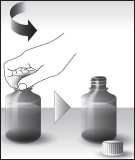
Figure 1
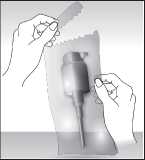
Figure 2
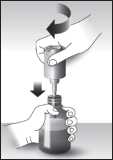
Figure 3
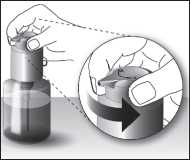
Figure 4.

Figure 6
Figure 5

Figure 7
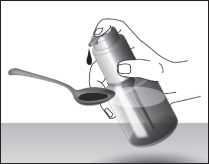
Figure 8
1. Take the screw cap off the bottle:
The cap must be turned anticlockwise, unscrewed completely and removed (figure 1).
2. Mounting the dosing pump on the bottle:
Take the dosing pump out of the plastic bag (figure 2) and place it on top of the bottle. Carefully slide the plastic dip tube into the bottle. Hold the dosing pump onto the neck of the bottle and screw it clockwise until it fits firmly (figure 3). The dosing pump is only screwed on once, when starting the use, and it should never be unscrewed.
3. How the dosing pump works:
The dosing pump head has two positions and is easy to turn:
- anticlockwise to unlock and
- clockwise to lock.
The dosing pump head should not be pushed down while in the locked position. The solution can only be dispensed in the unlocked position. To unlock, turn the pump head in the direction of the arrow until it cannot be turned any further (figure 4). The dosing pump is then ready for use.
4. Preparing the dosing pump:
When used for the first time, the dosing pump does not dispense the correct amount of oral solution. Therefore, the pump must be prepared (primed) by pushing the dosing pump head down completely six times in a row (figure 5). Any solution dispensed during this step should be discarded.
The next time the dosing pump head is pushed downwards completely (equivalent to one pump actuation), it dispenses the correct dose (figure 6).
5. Correct use of the dosing pump:
Hold the bottle in a slightly tilted position.
Hold a glass with a little water or a spoon below the nozzle. Push down the dosing pump head in a firm but calm and steady manner - not too slowly (figure 7, figure 8).
The dosing pump head can then be released and is ready for the next pump actuation.
The dosing pump must only be used with the Deloz solution in the bottle provided, not for other substances or containers. If the pump does not function properly, consult your doctor or a pharmacist.
Lock the dosing pump after using Deloz.